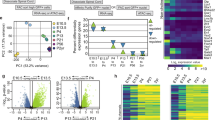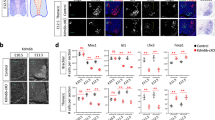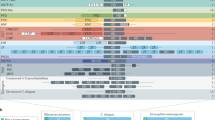Abstract
Many lines of evidence indicate that genetically distinct subtypes of motor neurons are specified during development1, with each type having characteristic properties of axon guidance and cell-body migration2. Motor neuron subtypes express unique combinations of LIM-type homeodomain factors that may act as intrinsic genetic regulators of the cytoskeletal events that mediate cell migration, axon navigation or both3,4,5,6,7. Although experimentally displaced motor neurons can pioneer new routes to their targets8,9,10,11, in many cases the axons of motor neurons in complete isolation from their normal territories passively follow stereotypical pathways dictated by the environment12,13,14,15,16. To investigate the nonspecific versus genetically controlled regulation of motor connectivity we forced all motor neurons to express ectopically a LIM gene combination appropriate for the subgroup that innervates axial muscles. Here we show that this genetic alteration is sufficient to convert the cell body settling pattern, gene-expression profile and axonal projections of all motor neurons to that of the axial subclass. Nevertheless, elevated occupancy of the axial pathway can override their genetic program, causing some axons to project to alternative targets.
This is a preview of subscription content, access via your institution
Access options
Subscribe to this journal
Receive 51 print issues and online access
$199.00 per year
only $3.90 per issue
Buy this article
- Purchase on Springer Link
- Instant access to full article PDF
Prices may be subject to local taxes which are calculated during checkout






Similar content being viewed by others
References
Tanabe, Y. & Jessell, T. M. Diversity and pattern in the developing spinal cord. Science 274, 1115 –1122 (1996).
Landmesser, L. The development of motor projection patterns in the chick hind limb. J. Physiol. (Lond.) 284, 391–414 (1978).
Tsuchida, T. et al. Topographic organization of embryonic motor neurons defined by expression of LIM homeobox genes. Cell 79, 957–970 (1994).
Varela-Echavarria, A., Pfaff, S. L. & Guthrie, S. Differential expression of LIM homeobox genes among motor neuron subpopulations in the developing chick brain stem. Mol. Cell. Neurosci. 8, 242–257 (1996).
Appel, B. et al. Motoneuron fate specification revealed by patterned LIM homeobox gene expression in embryonic zebrafish. Development 121, 4117–4125 (1995).
Jurata, L. W., Thomas, J. B. & Pfaff, S. L. Transcriptional mechanisms in the development of motor control. Curr. Opin. Neurobiol. 10, 72–79 (2000).
Pfaff, S. & Kintner, C. Neuronal diversification: development of motor neuron subtypes. Curr. Opin. Neurobiol. 8, 27–36 (1998).
Bell, E., Wingate, R. J. & Lumsden, A. Homeotic transformation of rhombomere identity after localized Hoxb1 misexpression. Science 284, 2168–2171 (1999).
Ferguson, B. A. Development of motor innervation of the chick following dorsal-ventral limb bud rotations. J. Neurosci. 3, 1760– 1772 (1983).
Lance-Jones, C. & Landmesser, L. Motoneurone projection patterns in the chick hind limb following partial reversals of the spinal cord. J. Physiol. 302, 581– 602 (1980).
Ferns, M. J. & Hollyday, M. Motor innervation of dorsoventrally reversed wings in chick/quail chimeric embryos. J. Neurosci. 13, 2463–2476 (1993).
Summerbell, D. & Stirling, R. V. The innervation of dorsoventrally reversed chick wings: evidence that motor axons do not actively seek out their appropriate targets. J. Embryol. Exp. Morphol. 61, 233–247 (1981).
Straznicky, C. The patterns of innervation and movements of ectopic hindlimb supplied by brachial spinal cord segments in the chick. Anat. Embryol. (Berl.) 167, 247–262 ( 1983).
Lance-Jones, C. C. Motoneuron projection patterns in chick embryonic limbs with a double complement of dorsal thigh musculature. Dev. Biol. 116, 387–406 (1986).
Whitelaw, V. & Hollyday, M. Position-dependent motor innervation of the chick hindlimb following serial and parallel duplications of limb segments. J. Neurosci. 3, 1216–1225 (1983).
O'Brien, M. K., Landmesser, L. & Oppenheim, R. W. Development and survival of thoracic motoneurons and hindlimb musculature following transplantation of the thoracic neural tube to the lumbar region in the chick embryo: functional aspects. J. Neurobiol. 21, 341–355 (1990).
Sharma, K. et al. LIM homeodomain factors Lhx3 and Lhx4 assign subtype identities for motor neurons. Cell 95, 817– 828 (1998).
Arber, S. et al. Requirement for the homeobox gene Hb9 in the consolidation of motor neuron identity. Neuron 23, 659– 674 (1999).
Thaler, J. et al. Active suppression of interneuron programs within developing motor neurons revealed by analysis of homeodomain factor HB9. Neuron 23, 675–687 ( 1999).
O'Gorman, S., Dagenais, N. A., Qian, M. & Marchuk, Y. Protamine-Cre recombinase transgenes efficiently recombine target sequences in the male germ line of mice, but not in embryonic stem cells. Proc. Natl Acad. Sci. USA 94, 14602– 14607 (1997).
Wetts, R. & Vaughn, J. E. Choline acetyltransferase and NADPH diaphorase are co-expressed in rat spinal cord neurons. Neuroscience 63, 1117–1124 (1994).
Lin, J. H. et al. Functionally related motor neuron pool and muscle sensory afferent subtypes defined by coordinate ETS gene expression. Cell 95, 393–407 ( 1998).
Lance-Jones, C. & Landmesser, L. Motoneurone projection patterns in embryonic chick limbs following partial deletions of the spinal cord. J. Physiol. (Lond.) 302, 559–580 (1980).
Goodhill, G. J. & Richards, L. J. Retinotectal maps: molecules, models and misplaced data. Trends Neurosci. 22, 529–534 (1999).
Thor, S., Andersson, S. G., Tomlinson, A. & Thomas, J. B. A LIM-homeodomain combinatorial code for motor-neuron pathway selection. Nature 397, 76–80 ( 1999).
Friedrich, G. & Soriano, P. Promoter traps in embryonic stem cells: a genetic screen to identify and mutate developmental genes in mice. Genes Dev. 5, 1513–1523 (1991).
Pfaff, S. L., Mendelsohn, M., Stewart, C. L., Edlund, T. & Jessell, T. M. Requirement for LIM homeobox gene Isl1 in motor neuron generation reveals a motor neuron-dependent step in interneuron differentiation. Cell 84, 309–320 (1996).
Acknowledgements
We thank A. Joyner and A. Auerbach for the training to generate chimaeric embryos; M. McLean for help with immunocytochemistry; S. O'Gorman for Cre mice and the lox–neo–lox cassette; B. Hogan for Lhx1; H. Westphal for Lhx3; L. Jurata, C. Lance-Jones, G. Lemke and J. Thomas; and J. Thaler for insightful comments on the manuscript. This work derives from initial studies on LIM genes while S.L.P. was a fellow with T. Jessell. The Human Frontiers Science Program provided postdoctoral support for K. S., and the National Institutes of Health provided training support for A.E.L. This research was funded by the National Institutes of Health. S.L.P. is a Basil O'Connor, McKnight, Pew, and Alfred P. Sloan Scholar.
Author information
Authors and Affiliations
Author notes
Correspondence and requests for materials should be addressed to S.L.P..
- Samuel L. Pfaff
Rights and permissions
About this article
Cite this article
Sharma, K., Leonard, A., Lettieri, K. et al. Genetic and epigenetic mechanisms contribute to motor neuron pathfinding . Nature 406, 515–519 (2000). https://doi.org/10.1038/35020078
Received:
Accepted:
Published:
Issue Date:
DOI: https://doi.org/10.1038/35020078
This article is cited by
-
The histone demethylase Kdm6b regulates subtype diversification of mouse spinal motor neurons during development
Nature Communications (2022)
-
Development, functional organization, and evolution of vertebrate axial motor circuits
Neural Development (2018)
-
EphrinB2 sharpens lateral motor column division in the developing spinal cord
Neural Development (2015)
-
Mechanisms controlling neuromuscular junction stability
Cellular and Molecular Life Sciences (2015)
-
Transcriptional regulation of guidance at the midline and in motor circuits
Cellular and Molecular Life Sciences (2014)
Comments
By submitting a comment you agree to abide by our Terms and Community Guidelines. If you find something abusive or that does not comply with our terms or guidelines please flag it as inappropriate.



